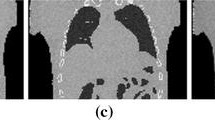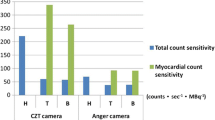Abstract
Purpose
One of the main factors contributing to the accuracy of attenuation correction for SPECT imaging using transmission computed tomography (TCT) with an external gamma-ray source is the radionuclide count. To reduce deterioration of TCT images due to inadequate radionuclide counts, a correction method, segmented attenuation correction (SAC), in which TCT data are transformed into several components (segments) such as water, lungs and spine, providing a satisfactory attenuation correction map with less counts, has been developed. The purpose of this study was to examine the usefulness of SAC for myocardial SPECT with attenuation correction.
Methods
A myocardial phantom filled with Tc-99m was scanned with a triple headed SPECT system, equipped with one cardiac fan beam collimator for TCT and two parallel hole collimators for ECT. As an external gamma-ray source for TCT, 740 MBq of Tc-99m was also used. Since Tc-99m was also used for ECT, the TCT and ECT data were acquired separately. To make radionuclide counts, the TCT data were acquired in the sequential repetition mode, in which a 3-min-rotation was repeated 7 times followed by a 10-min-rotation 4 times (a total of 61 minutes). The TCT data were reconstructed by adding some of these rotations to make TCT maps with various radionuclide counts. Three types of SAC were used: (a) 1-segment SAC in which the body structure was regarded as water, (b) 2-segment SAC, in which the body structure was regarded as water and lungs, and (c) 3-segment SAC, in which the body structure was regarded as water, lungs and spine. We compared corrected images obtained with non-segmentation methods, and with 1-to 3-segment SACs. We also investigated the influence of radionuclide counts of TCT (3, 6, 9, 12, 15, 18, 21, 31, 41, 51, 61 min acquisition) on the accuracy of the attenuation correction.
Results
Either 1-segment or 2-segment SAC was sufficient to correct the attenuation. When non-segmentation TCT attenuation methods were used, rotations of at least 31 minutes were required to obtain sufficiently large counts for TCT. When the 3-segment SAC was used, the minimal acquisition time for a satisfactory TCT map was 7 min.
Conclusion
The 3-segment SAC was effective for attenuation correction, requiring fewer counts (about 1/5 of the value for non-segmentation TCT), or less radiation for TCT.
Similar content being viewed by others
References
Van LaereK, Koole M, Kauppinen T, Monsieurs M, Bouwens L, Dierck R. Nonuniform transmission in brain SPECT using201Tl,153Gd, and99mTc static line sources: Anthropomorphic dosimetry studies and influence on brain quantification.J Nucl Med 2000; 41:2051–2062.
Meikle SR, Bailey DL, Hooper PK, Eberl S, Hutton BF, Jones WF, et al. Simultaneous emission and transmission measurements for attenuation correction in whole-body PET.J Nucl Med 1995; 36:1680–1688.
Meikle SR, Dahlbom M, Cherry SR. Attenuation correction using count-limited transmission data in positron emission tomography.J Nucl Med 1993; 34:143–150.
Xu M, Luk WK, Cutler PD, Digby WM. Local threshold for segmented attenuation correction of PET imaging of the thorax.IEEE Trans Nucl Sci 1994; 41:1532–1537.
Xu M, Cutler P, Luk WK. Adaptive segmented attenuation correction for whole-body PET imaging.IEEE Trans Nucl Sci 1996; 43:331–336.
Takahashi T, Murase K, Higashino H, Sogabe I, Sakamoto K. Receiver operating characteristic (ROC) analysis of image reconstructed with iterative expectation maximization algorithms.Ann Nucl Med 2001; 15:521–525.
Ogawa K. Simulation study of triple-energy-window scatter correction in combined Tl-201, Tc-99m SPECT.Ann Nucl Med 1995; 8:277–281.
Ichihara T, Motomura N, Ogawa K, Hasegawa H, Hashimoto J, Kubo A. Evaluation of SPET quantification of simultaneous emission and transmission imaging of the brain using a multidetector SPET system with the TEW scatter compensation method and fan-beam collimation.Eur J Nucl Med 1996; 23:1292–1299.
Motomura N, Ichihara T, Takayama T, Nishihara K, Inouye T, Kataoka T, et al. Practical method for reducing truncation artifacts in a fan beam transmission CT system.J Nucl Med 1998; 39:178. (abstract)
Takahashi Y, Higashino H, Sogabe I, Sakamoto K, Murase K, Motomura N. Segmented attenuation correction by phantom experiment.KAKU IGAKU (Jpn J Nucl Med) 2000; 5:250. (abstract)
Murase K, Tanada S, Inoue T, Sugawara Y, Hamamoto K. Improvement of brain single photon emission tomography (SPET) using transmission data acqusition in a four-head SPET scanner.Eur J Nucl Med 1993; 20:32–38.
Stone CD, McCormick JW, Gilland DR. Effect of registration errors between transmission and emission scans on a SPECT system using sequential scanning.J Nucl Med 1998; 39:365–373.
Ardekani BA, Braun M, Hutton BF, Kanno I, Iida H. A fully automatic multimodality image registration algorithm.J Comput Assist Tomogr 1995; 19:615–623.
Takahashi Y, Murase K, Higashino H, Mochizuki T, Motomura N. Attenuation correction of myocardial SPECT images with X-ray CT: Effects of registration errors between X-ray CT and SPECT.Ann Nucl Med 2002; 16:431–435.
Hashimoto J, Ogawa K, Kubo A, Ichihara T, Motomura N, Takayama T. Application of transmission scan-based attenuation compensation to scatter-corrected thallium-201 myocardial single-photon emission tomographic images.Eur J Nucl Med 1998; 25:120–127.
Bocher M, Balan A, Krausz Y, Shrem Y, Lonn A, Wilk M, et al. Gamma camera-mounted anatomical X-ray tomography: technology, system characteristics and first images.Eur J Nucl Med 2000; 27:619–627.
Murase K, Tanada S, Inoue T, et al. Effect of misalignment between transmission and emission scans on SPECT images.J Nucl Med Technol 1993; 21:152–156.
Author information
Authors and Affiliations
Corresponding author
Rights and permissions
About this article
Cite this article
Takahashi, Y., Murase, K., Mochizuki, T. et al. Segmented attenuation correction for myocardial SPECT. Ann Nucl Med 18, 137–143 (2004). https://doi.org/10.1007/BF02985104
Received:
Accepted:
Issue Date:
DOI: https://doi.org/10.1007/BF02985104




